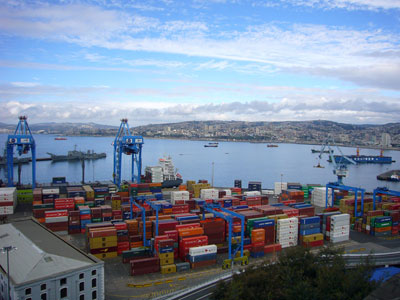Logistical Infrastructure of Ports could Become
the “Bottleneck” of Latin American Growth
 |
| Photo: anlopelope, Flickr |
At present, almost half of the economic development of Latin America and the Caribbean is attributable to trade, which passes mainly through ports. However, the infrastructure of seaports in most countries leaves much to be desired, and could become a major obstacle to growth.
According to Latin America and the Caribbean Containerized Port Throughputs 2010 produced by ECLAC, in 2010 the region’s 20 main container ports grew by 20.9%, which is much higher than in 2009 when regional activity dipped by 6.8%.
The same dynamic can be seen in Total tons handled, where the 20 main ports saw growth of 13.2%, compared with the previous year’s. Initial data for the first half of 2011 show significant growth in port throughputs, in terms of TEUs (twenty foot equivalent units) and tons for the entire region (thus resuming pre-crisis levels).
The two-figure growth rates in many ports point to the need to improve port infrastructure so that it does not become a bottleneck for future foreign trade.
ECLAC has pointed out growing port congestion in major regional ports, as well as widespread connectivity problems within national territories that not only push up logistics costs and bring down national competitiveness, but also significantly affect the quality of life of people living in the area.
Although some of the region’s countries have made investments, very few are taking concrete measures to tackle the changes that will be facing the sector in the coming years.
The widening of the Panama Canal, the presence of ever larger ships on the coasts of Latin America, the restructuring of logistical port networks and the operation of integrated global operators are a few of the elements that should be taken into account and that must focus attention on the urgent need to invest more and better in infrastructure. This investment should not be limited to ports, but must include the entire logistics chain.
According to ECLAC, the adoption of integrated and sustainable logistics and
mobility policies would encourage the sustainable development of infrastructure and the operation of transport
services, thus increasing economic competitiveness while also reducing logistics costs and negative transport
externalities, which ultimately promotes the well-being and development of the entire population.
More IN FOCUS
Demand for care is a
challenge for social protection systems in Latin America
Second seminar on telemedicine held in Venezuela
The sun - renewable energy with great potential for Latin America and the Caribbean
ECLAC reveals offices renovated following the
earthquake in 2010
| The seaport infrastructure of most countries leaves much to be desired and could become a serious obstacle to growth. | |
| Port congestion and connectivity problems with the rest of a national territory not only push up logistics cost but also seriously affect the quality of life of people living in the area. | |